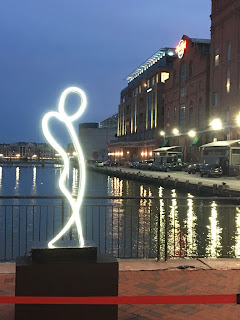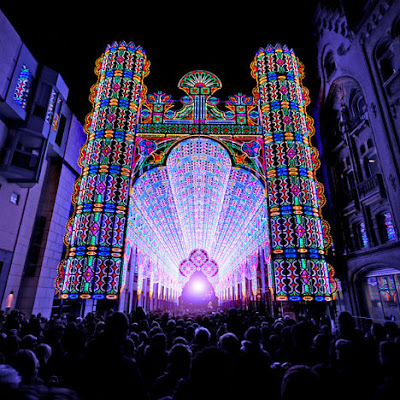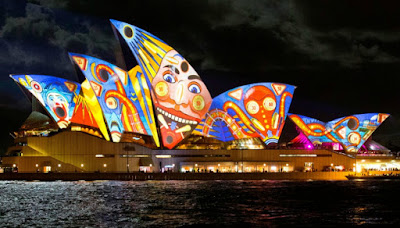 |
| Installation on Pratt Street: Close up required (Photo: Philipsen) |
With the second year soon under the belt, it is probably time to take the concept of an urban light festival, imported from other continents, and define its goals and desired outcomes specifically for Baltimore and put the concept on a more solid footing. The description of the festival as it can be found on the event website is vague and a walk through the exhibits confirms the fuzziness:
Light City Baltimore is the first large-scale, international light festival in the United States. In its first year, Light City welcomed more than 400,000 people from across the globe over seven nights.Of course, hardly any city in the US hasn't dabbled with using light as art, light as an attraction, a mood lifter or an illuminator of innovation. Buffalo' City of Light creates permanent large scale light installations on the city's industrial heritage structures..
Light City is a free festival that transforms Baltimore with large-scale light installations, performances, music and innovation. Central to Light City is the BGE Light Art Walk along Baltimore’s Inner Harbor, featuring more than 50 attractions including illuminated sculptures, projections, interactive technologies, performances, concerts, food vendors and a children’s area.
Light City’s innovation programming generates an ecosystem of ideas and learning during the day – while lights, performances and live music re-imagine Baltimore at night. The Baltimore Office of Promotion & The Arts, Inc. strives to mirror the rich diversity of Baltimore City in our staffing and programming while emphasizing cultural equity.
Light City Baltimore: Proof of concept (Photo: Philipsen)
Most cities have a specific set of holiday decorations expressing local preferences and some cities have light oriented festivals such as WaterFire in Providence, RI. Some of the light festivals in Europe draw visitors from far and wide and have successfully re-branded cities.
If Baltimore doesn't want to be a Johnny come lately and truly wants to draw people from hundreds of miles away to attend its light festival, it needs to do more than provide another city party with artistic installations that require moving close up to see them at all or require reading entire explanation panels to be understood. As laudable as the desire of using art and light as a way of illuminating Baltimore's specific social and economic ills, to have a future Baltimore's Light Festival needs a theme, large scale dazzling installations and innovation. Baltimore's festival needs to define more clearly what the event is and what is expected from it.
 |
| Nothing on the scale of Ghent's festival of lights (Belgium) |
It seems a more thorough investigation into light as such is in order. Light is ephemeral in that it has no physical presence. Whatever physical aspect supports the emittance of light may make an impressive display at night but could look goofy during the day. This is a familiar problem of architectural design, where a light fixture has to look good during the day and at night. But with new technologies the need for a "fixture" disappears.
People crave for light, especially at the end of the dark season. Light can be uplifting and create many moods. In the shade of night light can create illusions and simulate another world just as light on a movie screen does. But it can also accentuate the daytime reality at night.
All LightCity installations currently are temporary. How about using artistic creativity to each year add a permanent installation until Baltimore becomes a festival of lights year-round? Philadelphia's artistic Schuylkill River bridge lighting has become an iconic permanent fixture. Baltimore's skyline across the Patapsco has become more dazzling every year, because more property owners added facade uplighting and lit signage to their buildings, many lightscan be turned to purple on Ravens game days. Could that beginning be turned into an even more creative orchestra of lights by animating it or coordinating it in whatever way? In some cities the lit windows of highrises spell messages that can be generated by a computer across an entire facade.
 |
| Baltimore's most visible light object is the ferris wheel, an established image, not innovative and not art Photo: Philipsen |
After the revolutions of light that came with the invention of electricity, light from gas tubes (neon) and laser we are currently in another revolution caused by the introduction of light emitting diodes as the source of lighting in lieu of filaments or gases. LED lighting allows an entire new way of using light that has barely been tapped to date. Never has it been easier or has it required less energy to create light in all colors of the rainbow and in ways that reveal the source less. LED lighting allows to make building or surface components such as facades, streets and walks visible in their entirety by embedding light into the materials. Baltimore could try to attract innovations and become a city-scale prototype of new applications.
LightCity Baltimore is an opportunity because no other City in the US has embraced a comprehensive light city concept yet. 2016 was a very successful proof of concept. 2017 in some ways is a step backwards in terms of scale and wow. For example the projections on the inside of the Columbus Center tent or structure integration as on last year's McKeldin Fountain were gone.
For really being able to redefine the world's perceptions of Baltimore, the show has to be ramped up. Maybe some of Mayor Pugh's 6000 additional lights in neighborhoods can become something creative as well.
Klaus Philipsen, FAIA
Neighborhoods
Smart Cities Collective about City Light Events
Weburbanist about city light installations
Baltimore Magazine video essay
Photo gallery:
 |
| Wrapped boat: The most dazzling light display is made by nature with the sunset displaying on teh Four Seasons Tower in Harbor East (Photo Philipsen) |
 |
| Strings illuminated from shorelight light beams |
 |
| Baltimore Visitor Center illumination available year round |
 |
| Dazzling lights elsewhere: Ghent |
 |
| Light festival Sidney |
 |
| Buffalo illuminated grain silos |
 |
| Jerusalem Light Festival |
Here is information from BOPA about the artists who will be involved in Neighborhood Lights.
Jonathan Taube (Resident Artist: Coldstream Homestead Montebello) — Jonathan Taube is an interdisciplinary sculptor practicing architecture in Baltimore. Taube, a native of New Orleans, graduated from the Maryland Institute College of Art (MICA) in 2010 and holds a master’s degree in architecture from Tulane University. Taube is looking forward to picking up his socially engaged sculpture practice now back in the magnetic Baltimore City. In 2008, Taube directed a large scale civic action called the Baltimore Sweep Action Parade in partnership with the Walters Art Museum and MICA. He is excited to be exploring the medium of light in the urban and public space in CHM.
April Danielle Lewis | Labbodies (Resident Artists: Greater Mondawmin) — April Danielle Lewis is an artist, organizer, curator and community cultivator. In 2009, April earned a Bachelor of Science degree in art and design with a concentration in printmaking from Towson University and an associate of art’s degree in visual art from Anne Arundel Community College in 2006. Labbodies is a performance art laboratory that provides opportunities for performance artists to exhibit their work. Labbodies has been commissioned by The Baltimore Museum of Art, Art in Odd Places, Transmodern Festival, Artscape, Light City, Bromo Arts and Entertainment District and Station North Arts and Entertainment District to create their signature interactive performance art events.
Maura Dwyer of Spectrum Studio (Resident Artist: Hamilton-Lauraville) — Maura Dwyer is an interdisciplinary artist from Baltimore currently working on ways to contribute to community and awareness-driven art practices. In her professional work, she partners with artists, schools, non-profits and small businesses to create murals and teach workshops. She finds the most joy in working on original content that speaks to a collective experience that may be under-told, whether a live performance, a short film, mural or illustration.
Isaac Ewart (Resident Artist: Hampden) — Born in California, Isaac Ewart has been a Baltimore City resident for the last four years. His love for art-making came from his father; Isaac remembers running around his father’s art openings as a child. His passion for art-making led him to start his own painting practice. Eventually he was struck with the notion that these paintings needed to move. His animations focus on the tactile quality of fine art blended with a passion for storytelling.
Laure Drogoul (Resident Artist: Little Italy) — Laure Drogoul is an interdisciplinary artist, olfactory spelunker and cobbler of situations who lives in Baltimore. Laure works with a wide range of media including projects in which she creates sculpture, performances and events that invite the viewer to be an active participant. She has exhibited and performed internationally and nationally, including at the International House of Japan in Tokyo, Corcoran Gallery of Art, Washington Project for the Arts, Baltimore Museum of Art, PS122 and the Center for Architecture in New York. She has received Maryland State Artist awards and a Franklin Furnace Award for Performance Art and has been a recipient of a US/Japan Creative Artist Fellowship. In 2006, Drogoul won the Janet and Walter Sondheim Artscape Prize.
Malaika Aminata Clements (Resident Artist: Sandtown-Winchester) — Malaika Aminata Clements is a freelance life experiencer whose ultimate purpose is to promote self-acceptance and understanding through creative expression. In 2013, she graduated from Morgan State University
 |
| Image by Malaika Aminata |
Wickerham & Lomax (Resident Artists: Station North) — Wickerham & Lomax is the collaborative name of Baltimore-based artists Daniel Wickerham (born in Columbus, OH) and Malcolm Lomax (born in Abbeville, SC). Their practice is based on the accelerated exchange of frivolous information, gossip, and codified language that crystallizes into accessible forms in hopes of giving dignity to that exchange.
Jose Andres Rosero-Curet (Resident Artist: Waverly) — Jose Rosero is a Puerto Rican-born arts technologist from Baltimore. Since 2014, Jose has performed live video projection for notable acts such as TT the Artist, Black Sage, Hi$to and Mighty Mark. His work has been featured at events including the Transmodern Festival, Art/Sound Now, Light City 2016 and Fields Festival. Jose’s dynamic visuals and interactive installations guide audiences into new realms through creative use of light and sound.

Now that we are through year 2 on this it is time to take a step back and think about what the city is doing. Light City hits several of the right notes, getting people to move around at night. In that sense remove some of the government/culture-based paranoia instilled in us after 911 about safety and the boogieman we can't see in the dark. It also brings out diversity, people from everywhere enjoying the festival together unlike Artscape and boat festivals that increasingly seem to cater to one demographic.
ReplyDeleteBut you are right, this festival does seem to stop slightly short, just like the last few Artscapes. It could go further, do more, be more cutting edge. BOPA does a great job running this festival but BOPA answers to the tourism department. Tourism professionals like things safe and bland. Shock and Awe is not part of their repertoire. As long as corporate America is funding Light City and the city is running the show, we get what we get.